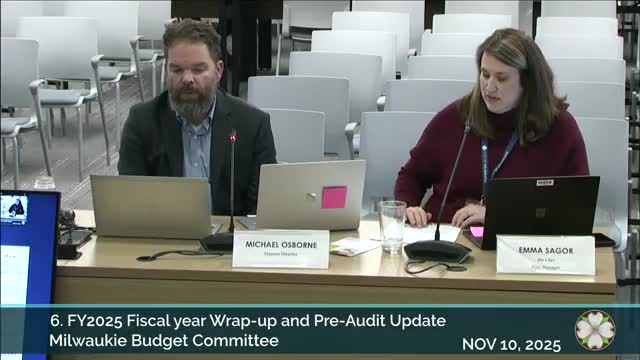Milwaukie budget committee kicks off FY26 with conservative forecast and new revenue tools
November 11, 2025 | Milwaukie, Clackamas County, Oregon
This article was created by AI summarizing key points discussed. AI makes mistakes, so for full details and context, please refer to the video of the full meeting. Please report any errors so we can fix them. Report an error »

Milwaukie’s budget committee met November 10 to begin the FY26 budget process, reviewing unaudited FY25 results and a five‑year forecast that relies on modest revenue growth while warning of structural pressures.
City Manager Emma Savore and Finance Director Michael Osborne told the committee that the general fund came in above budget for FY25 — “we came in at a 107% of what we budgeted,” Osborne said — and that recent revenue moves have improved the outlook. Key new revenue actions they cited included a public safety fee, a right‑of‑way license fee increase and an upcoming credit‑card convenience fee on utility bills.
Savore framed the budget kickoff around a “financial stability strategy” of three parts: stabilize costs, maximize existing revenue and find new revenue streams. “The piggy bank is not open,” she told the committee, urging “modest prioritized investments” while maintaining core services.
Osborne presented a conservative forecast that assumes 3–5% general fund revenue growth over the biennium. Under that scenario the city remains in the black through the next five years, but staff projected the city’s 25% policy reserve could be breached in FY28 without further adjustments. Savore said any larger long‑term revenue move — such as a property tax change — would require multi‑year community engagement.
Staff highlighted areas of pressure: IT subscription costs, facilities and fleet inflation, and stormwater and transportation project spending. They also said they would be cautious on capital budgeting to avoid overpromising deliverables.
The committee received the presentation and directed staff to continue refining forecasts and to bring more detailed budget proposals and capital planning materials during the formal budget calendar in February and April.
What’s next: Finance and department teams will finalize budget narratives and performance measures; the city plans a CIP and utility‑rate deep dive in February, department head presentations in May and adoption in June if schedules hold.
City Manager Emma Savore and Finance Director Michael Osborne told the committee that the general fund came in above budget for FY25 — “we came in at a 107% of what we budgeted,” Osborne said — and that recent revenue moves have improved the outlook. Key new revenue actions they cited included a public safety fee, a right‑of‑way license fee increase and an upcoming credit‑card convenience fee on utility bills.
Savore framed the budget kickoff around a “financial stability strategy” of three parts: stabilize costs, maximize existing revenue and find new revenue streams. “The piggy bank is not open,” she told the committee, urging “modest prioritized investments” while maintaining core services.
Osborne presented a conservative forecast that assumes 3–5% general fund revenue growth over the biennium. Under that scenario the city remains in the black through the next five years, but staff projected the city’s 25% policy reserve could be breached in FY28 without further adjustments. Savore said any larger long‑term revenue move — such as a property tax change — would require multi‑year community engagement.
Staff highlighted areas of pressure: IT subscription costs, facilities and fleet inflation, and stormwater and transportation project spending. They also said they would be cautious on capital budgeting to avoid overpromising deliverables.
The committee received the presentation and directed staff to continue refining forecasts and to bring more detailed budget proposals and capital planning materials during the formal budget calendar in February and April.
What’s next: Finance and department teams will finalize budget narratives and performance measures; the city plans a CIP and utility‑rate deep dive in February, department head presentations in May and adoption in June if schedules hold.
View full meeting
This article is based on a recent meeting—watch the full video and explore the complete transcript for deeper insights into the discussion.
View full meeting
